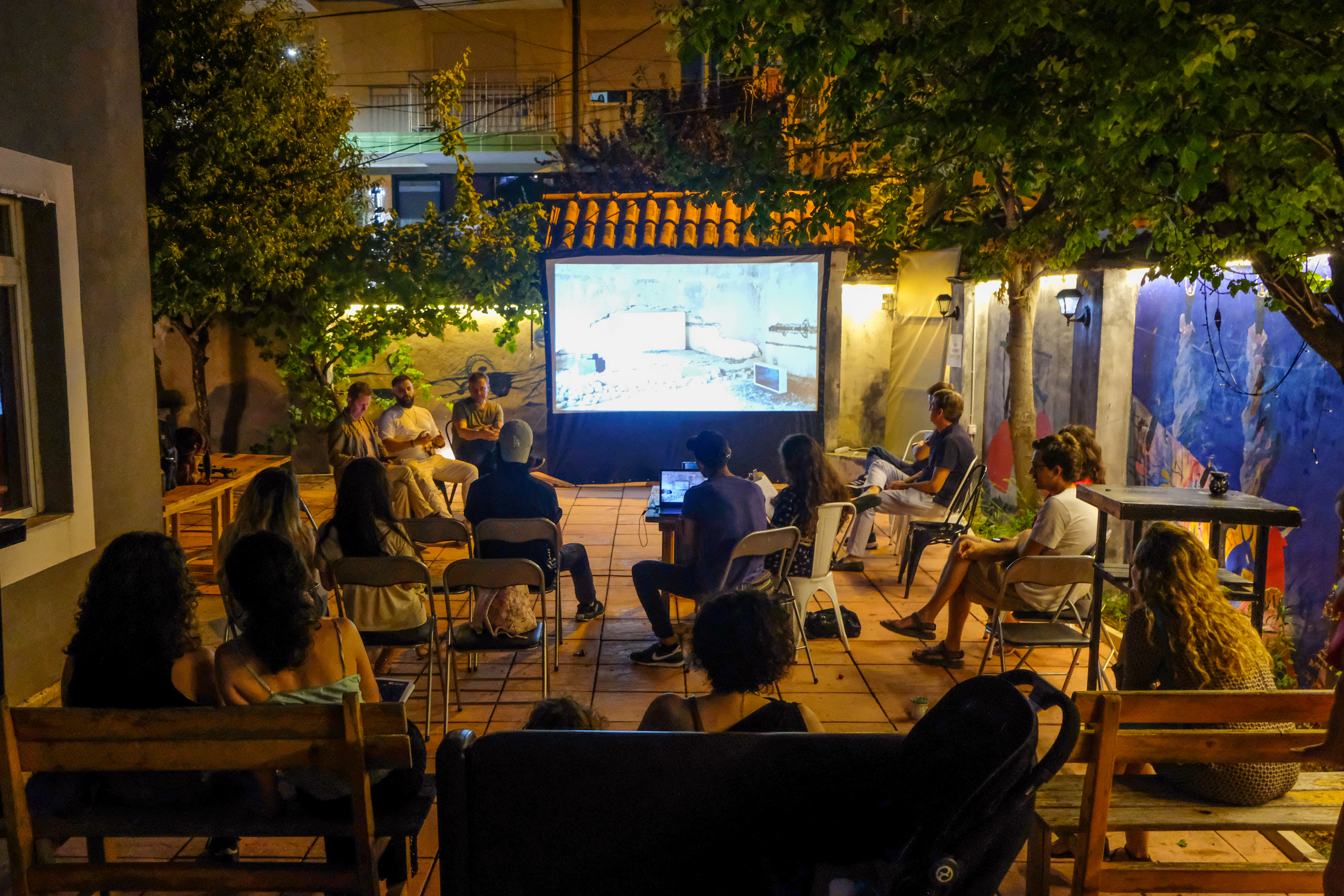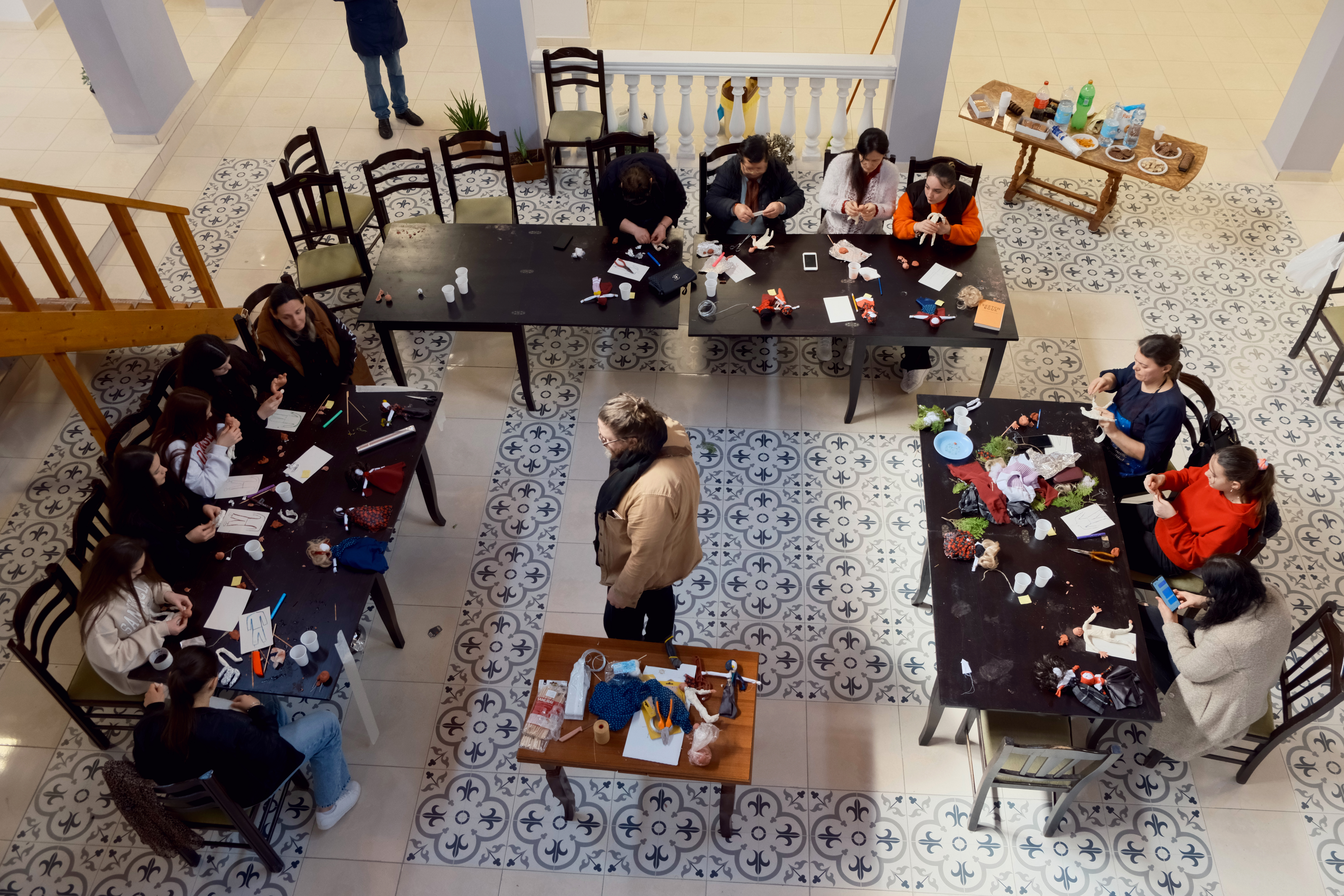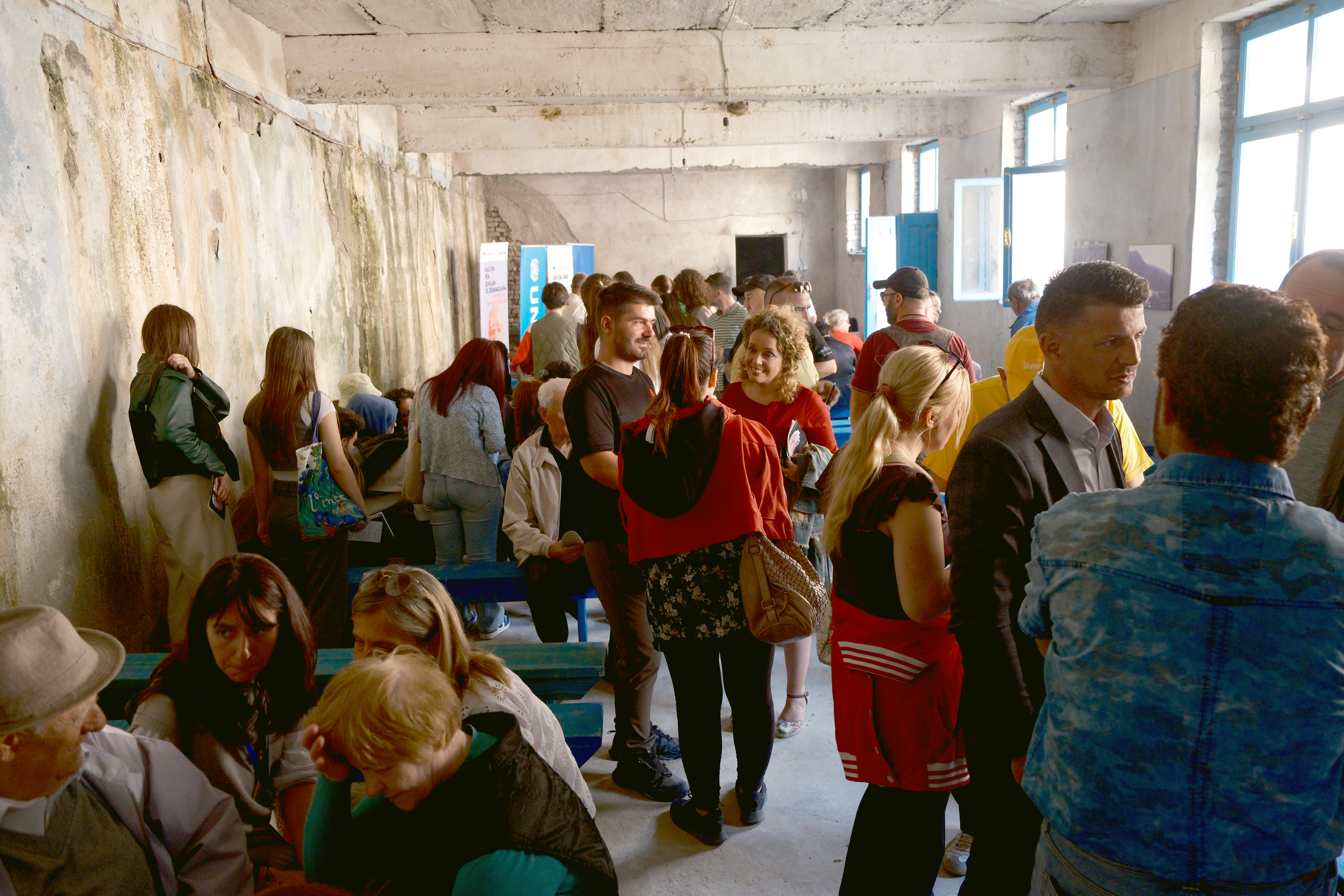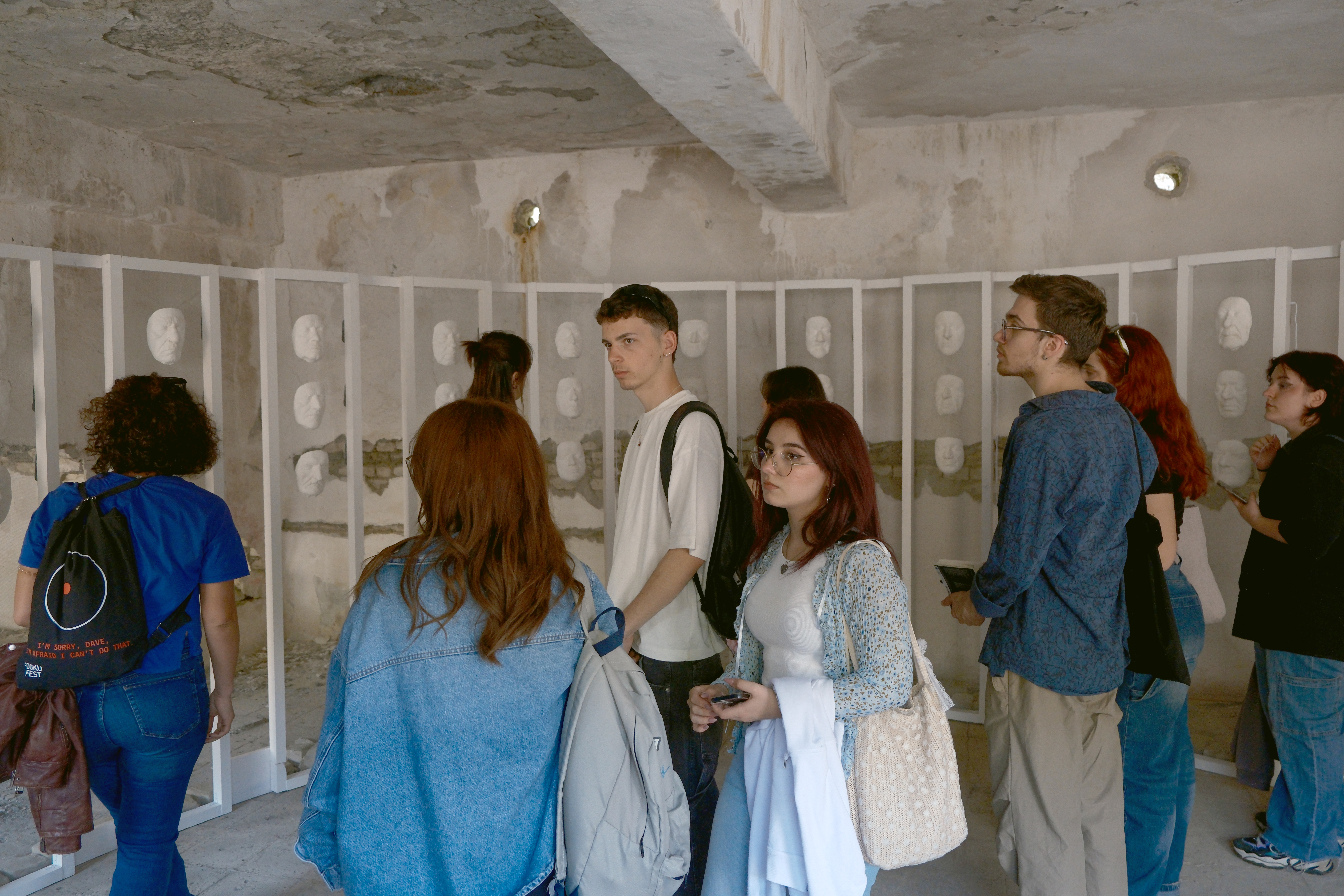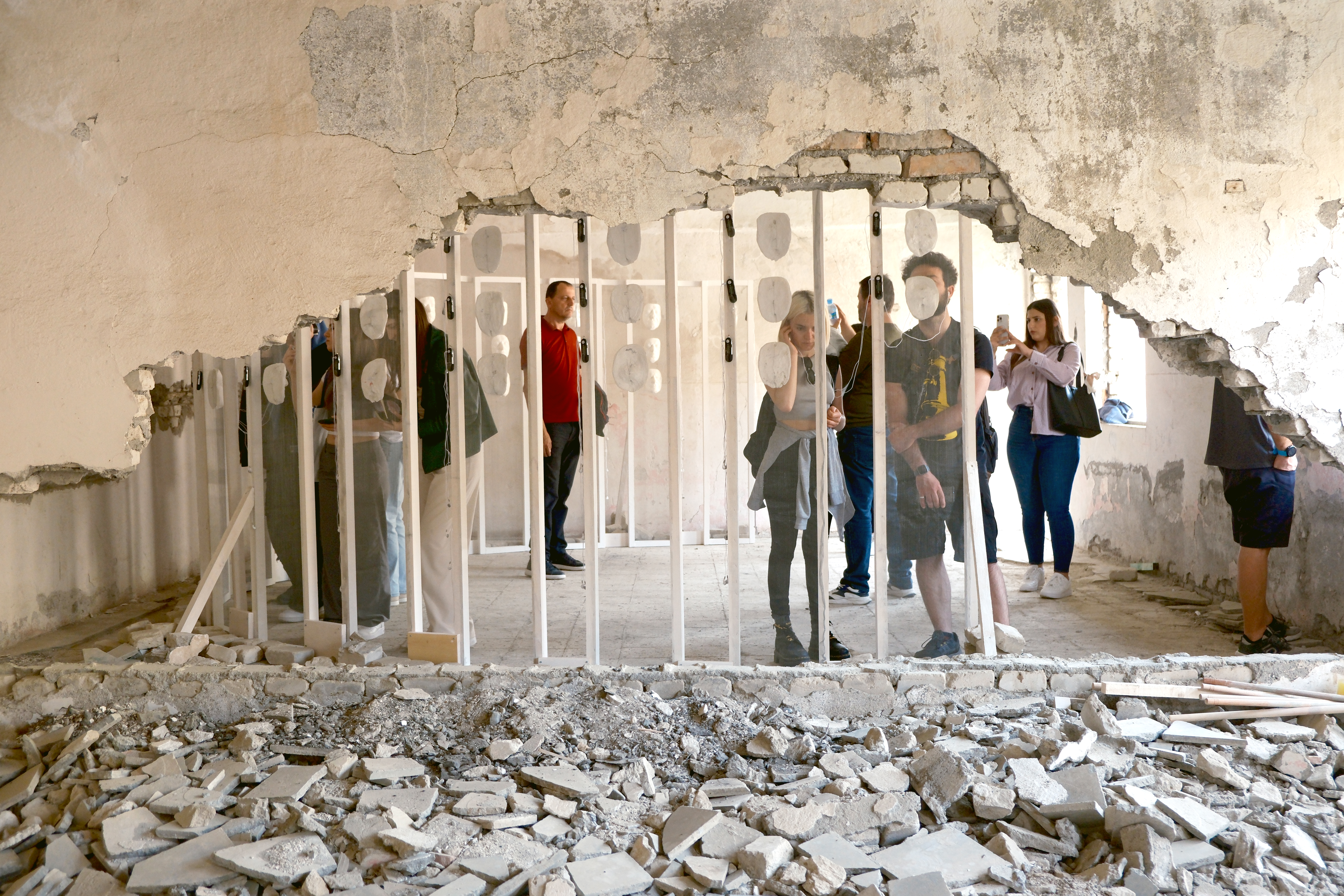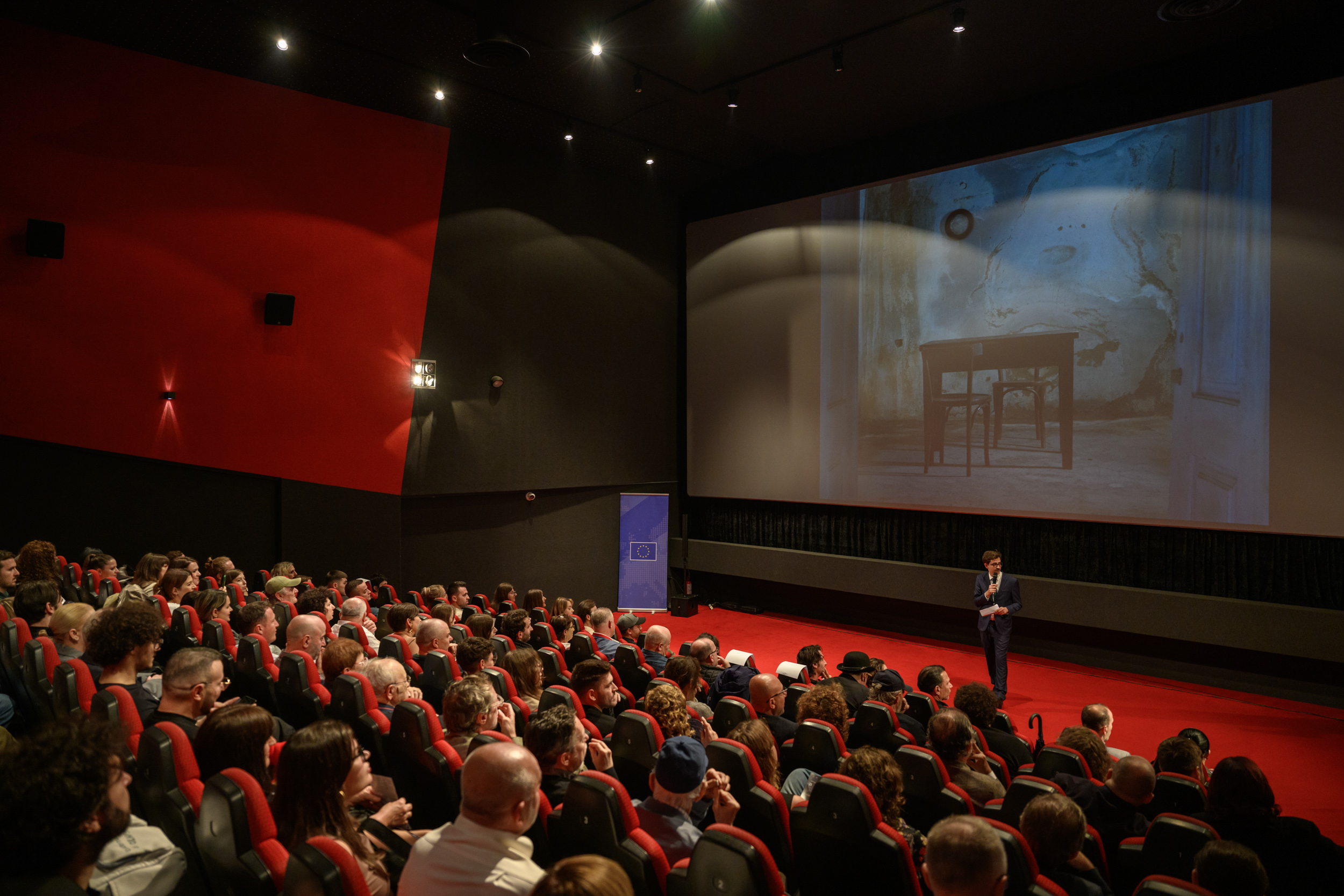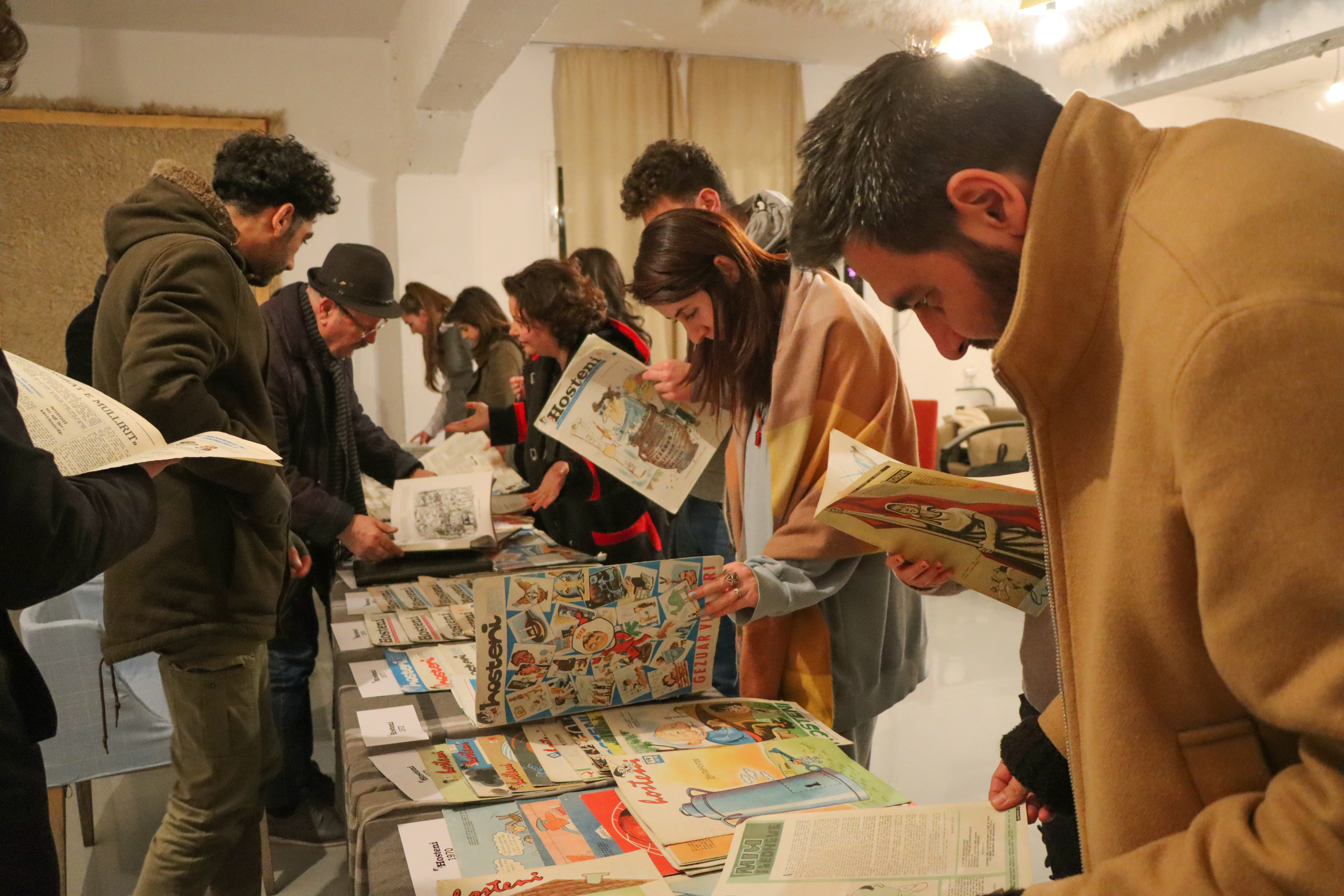Prioritising the places and people that need it the most
The Culture for Sustainable Development
The Culture for Sustainable Development: The Untapped Potential
Reviving the past, shaping the future—Tek Bunkeri’s project brings history to life through art, storytelling, and community engagement. With powerful workshops, a compelling short film, and creative expressions like sculpture and crafts, we transform Spaç Prison into a space of remembrance, dialogue, and cultural revival.
Albania
National
It addresses urban-rural linkages
It refers to other types of transformations (soft investment)
Yes
2024-10-18
Yes
EU4Culture Albania
No
No
As a representative of an organisation
The Culture for Sustainable Development: The Untapped Potential project by Tek Bunkeri transformed Spaç Prison into a space of remembrance and cultural reflection, using art to preserve history and engage communities. It highlighted Albania’s communist past while empowering youth, artists, and marginalized groups.
Target Groups:
• Former political prisoners and their families
• Youth (students, artists, and young professionals)
• Women artisans and cultural heritage practitioners
• Experts in history, culture, and human rights
• Local communities in Tirana, Rrëshen, and Spaç
Objectives & Achievements:
- Preserved the memory of former political prisoners through 49 sculpture portraits and life story recordings for a permanent exhibition.
- Engaged youth and women in creative workshops on sculpture, printmaking, and traditional crafts, producing over 230 artworks.
- Produced a short film, premiered to 300 people, raising awareness of historical narratives.
- Reached over 800 participants, including students, artists, and institutions, increasing public awareness by 30%.
- Organized five open discussions, six institutional meetings, and multiple partnerships to advocate for Spaç Prison’s recognition.
By merging art, history, and community action, the project revived Albania’s cultural heritage, ensuring the past continues to inspire future generations.
Target Groups:
• Former political prisoners and their families
• Youth (students, artists, and young professionals)
• Women artisans and cultural heritage practitioners
• Experts in history, culture, and human rights
• Local communities in Tirana, Rrëshen, and Spaç
Objectives & Achievements:
- Preserved the memory of former political prisoners through 49 sculpture portraits and life story recordings for a permanent exhibition.
- Engaged youth and women in creative workshops on sculpture, printmaking, and traditional crafts, producing over 230 artworks.
- Produced a short film, premiered to 300 people, raising awareness of historical narratives.
- Reached over 800 participants, including students, artists, and institutions, increasing public awareness by 30%.
- Organized five open discussions, six institutional meetings, and multiple partnerships to advocate for Spaç Prison’s recognition.
By merging art, history, and community action, the project revived Albania’s cultural heritage, ensuring the past continues to inspire future generations.
Memory
Art
Historical Justice
Community Engagement
Cultural Heritage
The Culture for Sustainable Development: The Untapped Potential project by Tek Bunkeri created lasting impact through skill-building, cultural preservation, and institutional engagement, ensuring its benefits extend beyond the project’s duration. The project empowered youth and women artisans through workshops in sculpture, printmaking, and traditional crafts, equipping them with marketable skills. Over 230 artworks were produced, and two young women received support to develop business ideas related to traditional craft making. Tek Bunkeri is exploring market opportunities for selling these artisan products in Tirana and Rrëshen, fostering economic sustainability. Additionally, the 49 sculpture portraits and life story recordings of former political prisoners were permanently installed at Spaç Prison, transforming it into a cultural and historical landmark. This enhances cultural tourism, attracting visitors and preserving collective memory without requiring further organizational involvement.
Through open discussions and a short film, the project deepened public understanding of Albania’s communist past. The short film, premiered to 300 people, will continue to serve as an educational and lobbying tool, fostering critical reflection and civic engagement. It is also being adapted into a theater performance that will tour Tirana, Korça, and Shkodra, further expanding its impact. Strong partnerships were built with key institutions, including the Ministry of Culture, the Institute for the Politically Persecuted, the Authority of Files, municipalities, universities, and media. These collaborations lay the groundwork for future projects, ensuring continued efforts in cultural heritage protection, historical awareness, and creative industry development. By integrating economic empowerment, cultural preservation, and civic education, the project sets a model for sustainable interventions, ensuring a long-term impact on Albania’s cultural and historical landscape.
Through open discussions and a short film, the project deepened public understanding of Albania’s communist past. The short film, premiered to 300 people, will continue to serve as an educational and lobbying tool, fostering critical reflection and civic engagement. It is also being adapted into a theater performance that will tour Tirana, Korça, and Shkodra, further expanding its impact. Strong partnerships were built with key institutions, including the Ministry of Culture, the Institute for the Politically Persecuted, the Authority of Files, municipalities, universities, and media. These collaborations lay the groundwork for future projects, ensuring continued efforts in cultural heritage protection, historical awareness, and creative industry development. By integrating economic empowerment, cultural preservation, and civic education, the project sets a model for sustainable interventions, ensuring a long-term impact on Albania’s cultural and historical landscape.
The Culture for Sustainable Development: The Untapped Potential project by Tek Bunkeri combined artistic excellence with historical storytelling to create a deeply immersive and high-quality cultural experience. By blending sculpture, film, craft-making, and interactive discussions, the project transformed Spaç Prison into a powerful space for remembrance and creative expression.
Aesthetically, the 49 sculpture portraits of former political prisoners were meticulously crafted, capturing not only their likenesses but also the emotional weight of their stories. These sculptures, displayed alongside 49 recorded life testimonies, provided a multi-sensory experience, allowing visitors to engage with history in a profound way. The short film, developed through a screenplay competition and produced with high artistic and technical standards, added a dynamic and cinematic dimension to the project, further elevating its impact.
Workshops in printmaking, ceramics, and puppet-making engaged participants in hands-on artistic creation, fostering self-expression and craftsmanship while connecting them with historical themes. The project's design ensured accessibility and inclusivity, drawing in youth, artists, and marginalized communities to contribute their voices and perspectives.
Through curated exhibitions, an evocative film, and participatory art experiences, the project set a new benchmark in artistic quality and cultural engagement. By merging historical memory with contemporary artistic expression, it demonstrated how culture can preserve the past, inspire dialogue, and enrich collective identity. The project stands as a model for innovative cultural storytelling, proving that aesthetics and quality design can make history tangible and relevant to new generations.
Aesthetically, the 49 sculpture portraits of former political prisoners were meticulously crafted, capturing not only their likenesses but also the emotional weight of their stories. These sculptures, displayed alongside 49 recorded life testimonies, provided a multi-sensory experience, allowing visitors to engage with history in a profound way. The short film, developed through a screenplay competition and produced with high artistic and technical standards, added a dynamic and cinematic dimension to the project, further elevating its impact.
Workshops in printmaking, ceramics, and puppet-making engaged participants in hands-on artistic creation, fostering self-expression and craftsmanship while connecting them with historical themes. The project's design ensured accessibility and inclusivity, drawing in youth, artists, and marginalized communities to contribute their voices and perspectives.
Through curated exhibitions, an evocative film, and participatory art experiences, the project set a new benchmark in artistic quality and cultural engagement. By merging historical memory with contemporary artistic expression, it demonstrated how culture can preserve the past, inspire dialogue, and enrich collective identity. The project stands as a model for innovative cultural storytelling, proving that aesthetics and quality design can make history tangible and relevant to new generations.
The Culture for Sustainable Development: The Untapped Potential prioritized inclusion and accessibility, ensuring that diverse voices and communities were actively engaged in historical remembrance and cultural expression. The project created opportunities for former political prisoners, youth, women artisans, marginalized groups, and the general public to participate in meaningful cultural and artistic activities, fostering a sense of belonging and shared heritage.
By offering free and open workshops, the project removed financial barriers, making participation accessible to young artists, students, and economically disadvantaged individuals. The workshops in sculpture, printmaking, and traditional crafts empowered participants by providing them with practical skills, fostering economic opportunities for women artisans and young creators. Additionally, the short film and exhibition at Spaç Prison were designed to be widely accessible, allowing visitors to engage with historical narratives through a multi-sensory experience that combined visual art, storytelling, and recorded testimonies.
The project also emphasized inclusive dialogue through open discussions, human library events, and institutional partnerships with universities, civil society organizations, and public institutions. This approach encouraged intergenerational and cross-sector engagement, bridging gaps between former political prisoners, young creatives, and policymakers. Furthermore, collaborations with the Ministry of Culture, the Institute for the Politically Persecuted, and local municipalities ensured that the project's outcomes contributed to broader cultural policy and heritage preservation efforts.
By integrating participation, diverse representation, and collaborative governance, the project sets an example for inclusive cultural programming. It demonstrates how art and history can bring together different segments of society to foster dialogue, social cohesion, and collective memory.
By offering free and open workshops, the project removed financial barriers, making participation accessible to young artists, students, and economically disadvantaged individuals. The workshops in sculpture, printmaking, and traditional crafts empowered participants by providing them with practical skills, fostering economic opportunities for women artisans and young creators. Additionally, the short film and exhibition at Spaç Prison were designed to be widely accessible, allowing visitors to engage with historical narratives through a multi-sensory experience that combined visual art, storytelling, and recorded testimonies.
The project also emphasized inclusive dialogue through open discussions, human library events, and institutional partnerships with universities, civil society organizations, and public institutions. This approach encouraged intergenerational and cross-sector engagement, bridging gaps between former political prisoners, young creatives, and policymakers. Furthermore, collaborations with the Ministry of Culture, the Institute for the Politically Persecuted, and local municipalities ensured that the project's outcomes contributed to broader cultural policy and heritage preservation efforts.
By integrating participation, diverse representation, and collaborative governance, the project sets an example for inclusive cultural programming. It demonstrates how art and history can bring together different segments of society to foster dialogue, social cohesion, and collective memory.
The Culture for Sustainable Development: The Untapped Potential project by Tek Bunkeri engaged citizens, former political prisoners, youth, women artisans, and civil society, ensuring broad participation and deep impact. Over 800 individuals, including students, artists, historians, and marginalized groups, took part in workshops, discussions, and exhibitions. Participants in sculpture, printmaking, and craft workshops developed artistic and practical skills, creating over 230 artworks. These activities provided economic opportunities, particularly for women artisans and young creators in Rrëshen and Tirana. Former political prisoners played a key role in preserving their experiences, contributing to 49 sculpture portraits and life story recordings, ensuring their voices were heard. Open discussions and human library events fostered intergenerational dialogue, bridging the gap between those who endured Albania’s communist past and younger generations. As a result, public awareness increased by 30%, with many participants developing a stronger connection to their cultural heritage.
Civil society organizations expanded the project’s reach. Institutions like the Institute for the Politically Persecuted, the Authority of Files, and universities provided expertise, ensuring historical accuracy and educational relevance. Media and advocacy groups amplified the project’s message, while partnerships with the Ministry of Culture and local municipalities integrated its themes into broader cultural heritage preservation efforts. The short film, premiered to 300 people, was a result of this collective engagement.
By involving citizens and civil society at every stage, the project preserved historical memory and empowered individuals through artistic and educational experiences. The multi-stakeholder collaboration strengthened cultural advocacy, inspired new initiatives, and set a model for inclusive cultural programming in Albania.
Civil society organizations expanded the project’s reach. Institutions like the Institute for the Politically Persecuted, the Authority of Files, and universities provided expertise, ensuring historical accuracy and educational relevance. Media and advocacy groups amplified the project’s message, while partnerships with the Ministry of Culture and local municipalities integrated its themes into broader cultural heritage preservation efforts. The short film, premiered to 300 people, was a result of this collective engagement.
By involving citizens and civil society at every stage, the project preserved historical memory and empowered individuals through artistic and educational experiences. The multi-stakeholder collaboration strengthened cultural advocacy, inspired new initiatives, and set a model for inclusive cultural programming in Albania.
The Culture for Sustainable Development: The Untapped Potential project by Tek Bunkeri engaged stakeholders at local, regional, national, and European levels, ensuring a multi-layered approach to cultural preservation, education, and artistic engagement. Their roles ranged from strategic support to hands-on participation, significantly enhancing the project's impact.
At the local level, the Municipality of Mirdita, civil society organizations, and educational institutions facilitated community engagement by providing logistical support, venues, and outreach, ensuring broad participation, particularly among youth, women artisans, and politically persecuted communities.
At the regional level, institutions like Info Kulla Mirdita, the Museum of Mirdita, and the Cultural Center of Rrëshen helped integrate the project into the broader cultural and touristic framework, increasing visibility and attracting tourists, historians, and artists to Spaç Prison.
At the national level, the Ministry of Culture, the Institute for the Politically Persecuted, the Authority of Files, and universities provided expertise and research support, ensuring historical accuracy and strengthening cultural heritage advocacy. Media outlets helped amplify the project’s impact.
At the European level, international organizations and EU institutions attended events, supported public discussions, and fostered cross-border awareness. Their involvement added legitimacy to advocacy efforts for Spaç Prison’s recognition. The short film, premiered to 300 people, and the sculpture portraits and life story recordings, now installed at Spaç Prison, benefited from these collaborations.
This multi-stakeholder approach combined local expertise, national support, and European visibility, ensuring long-term impact in preserving historical memory, empowering communities, and strengthening Albania’s cultural heritage narrative.
At the local level, the Municipality of Mirdita, civil society organizations, and educational institutions facilitated community engagement by providing logistical support, venues, and outreach, ensuring broad participation, particularly among youth, women artisans, and politically persecuted communities.
At the regional level, institutions like Info Kulla Mirdita, the Museum of Mirdita, and the Cultural Center of Rrëshen helped integrate the project into the broader cultural and touristic framework, increasing visibility and attracting tourists, historians, and artists to Spaç Prison.
At the national level, the Ministry of Culture, the Institute for the Politically Persecuted, the Authority of Files, and universities provided expertise and research support, ensuring historical accuracy and strengthening cultural heritage advocacy. Media outlets helped amplify the project’s impact.
At the European level, international organizations and EU institutions attended events, supported public discussions, and fostered cross-border awareness. Their involvement added legitimacy to advocacy efforts for Spaç Prison’s recognition. The short film, premiered to 300 people, and the sculpture portraits and life story recordings, now installed at Spaç Prison, benefited from these collaborations.
This multi-stakeholder approach combined local expertise, national support, and European visibility, ensuring long-term impact in preserving historical memory, empowering communities, and strengthening Albania’s cultural heritage narrative.
The Culture for Sustainable Development: The Untapped Potential project by Tek Bunkeri integrated multiple disciplines, ensuring a comprehensive approach to cultural preservation and artistic engagement. It combined history, visual arts, filmmaking, anthropology, education, and cultural heritage management, fostering collaboration between experts, artists, and communities. Historians and researchers from the Institute for the Politically Persecuted, the Authority of Files, and universities ensured historical accuracy, while sculptors, printmakers, and artisans translated narratives into sculptures, printmaking, and ceramics. The short film, developed through a screenplay competition, brought together scriptwriters and directors, creating a high-quality audiovisual narrative that expanded the project's reach. Cultural heritage experts helped integrate the project into Spaç Prison’s historical framework, ensuring its long-term value as a site of remembrance.
These disciplines interacted, fostering an interactive, multi-disciplinary dialogue where history was not just documented but brought to life through art, film, and workshops. Historians provided narratives, which were interpreted visually through sculpture and printmaking and cinematically through the short film. Artists worked with heritage experts to ensure historical accuracy, while educators designed inclusive workshops. This interdisciplinary model created an immersive experience, where history was preserved, explored, and reimagined.
The added value of this multi-disciplinary approach was its ability to engage a diverse audience, making Albania’s historical memory more accessible. The collaboration between artists, historians, and educators ensured the project preserved the past while fostering critical thinking and creative expression. By bridging art, history, and education, the project set a model for interdisciplinary programming, ensuring a lasting impact.
These disciplines interacted, fostering an interactive, multi-disciplinary dialogue where history was not just documented but brought to life through art, film, and workshops. Historians provided narratives, which were interpreted visually through sculpture and printmaking and cinematically through the short film. Artists worked with heritage experts to ensure historical accuracy, while educators designed inclusive workshops. This interdisciplinary model created an immersive experience, where history was preserved, explored, and reimagined.
The added value of this multi-disciplinary approach was its ability to engage a diverse audience, making Albania’s historical memory more accessible. The collaboration between artists, historians, and educators ensured the project preserved the past while fostering critical thinking and creative expression. By bridging art, history, and education, the project set a model for interdisciplinary programming, ensuring a lasting impact.
The project introduced an innovative approach to cultural preservation and historical remembrance by blending art, storytelling, education, and community engagement. Unlike mainstream heritage projects that focus solely on documentation or conservation, this initiative used participatory art, film, and interactive experiences to create a living cultural dialogue.
One of its most innovative aspects was integrating sculpture, printmaking, and crafts to interpret Albania’s communist past. Instead of static museum exhibitions, the project empowered youth, women artisans, and former political prisoners to actively shape history through artistic creation. The 49 sculpture portraits and recorded testimonies preserved survivors’ stories in a highly personal format rather than conventional archives.
Another innovation was the use of film as an advocacy tool. While historical films often rely on documentaries, this project encouraged a creative reinterpretation of the past through a screenplay competition, resulting in an artistically crafted short film. This method engaged young filmmakers, making history more accessible while maintaining high cinematic quality.
Additionally, the project introduced a new model for public engagement in historical sites like Spaç Prison. Instead of a passive monument, Tek Bunkeri activated the space through discussions, workshops, and exhibitions, turning it into a cultural hub. The inclusion of women artisans and young artists demonstrated that cultural heritage can foster economic empowerment and skill-building.
Compared to mainstream heritage projects, which often focus on top-down narratives, this project was deeply participatory, ensuring history was not just studied but reinterpreted and owned. By merging art, education, and activism, the project redefined cultural heritage engagement, making it more inclusive, dynamic, and impactful for future generations.
One of its most innovative aspects was integrating sculpture, printmaking, and crafts to interpret Albania’s communist past. Instead of static museum exhibitions, the project empowered youth, women artisans, and former political prisoners to actively shape history through artistic creation. The 49 sculpture portraits and recorded testimonies preserved survivors’ stories in a highly personal format rather than conventional archives.
Another innovation was the use of film as an advocacy tool. While historical films often rely on documentaries, this project encouraged a creative reinterpretation of the past through a screenplay competition, resulting in an artistically crafted short film. This method engaged young filmmakers, making history more accessible while maintaining high cinematic quality.
Additionally, the project introduced a new model for public engagement in historical sites like Spaç Prison. Instead of a passive monument, Tek Bunkeri activated the space through discussions, workshops, and exhibitions, turning it into a cultural hub. The inclusion of women artisans and young artists demonstrated that cultural heritage can foster economic empowerment and skill-building.
Compared to mainstream heritage projects, which often focus on top-down narratives, this project was deeply participatory, ensuring history was not just studied but reinterpreted and owned. By merging art, education, and activism, the project redefined cultural heritage engagement, making it more inclusive, dynamic, and impactful for future generations.
The project employed a participatory, interdisciplinary, and community-driven approach, ensuring that historical remembrance, artistic expression, and cultural preservation were not just passively observed but actively shaped. Former political prisoners played a central role by contributing to 49 sculpture portraits and life story recordings, preserving their narratives in an artistic and emotional format. Youth, women artisans, and artists engaged in hands-on workshops, transforming historical themes into sculpture, printmaking, and crafts, fostering both creative expression and economic empowerment.
By merging visual arts, filmmaking, history, anthropology, and cultural heritage studies, the project created a multifaceted and immersive experience. Historians ensured historical accuracy, while artists translated narratives into tangible forms. The short film, developed through a screenplay competition, encouraged young creatives to reinterpret history, making it more accessible. Unlike traditional preservation efforts, the project activated Spaç Prison as a cultural hub, turning it into a space for learning, artistic reflection, and dialogue through exhibitions, discussions, and screenings.
Institutional collaboration played role in ensuring long-term impact. The project engaged the Ministry of Culture, the Institute for the Politically Persecuted, the Authority of Files, universities, and media to integrate its outcomes into broader cultural heritage policies and education. The sculpture portraits and recorded testimonies became a permanent cultural resource, while the short film continues to serve as an educational and advocacy tool. Training provided to women artisans and young artists fostered ongoing skill development and creative entrepreneurship.
By combining participatory art, historical preservation, education, and advocacy, the project set a new standard for cultural engagement in Albania, making history tangible, personal, and artistically vibrant.
By merging visual arts, filmmaking, history, anthropology, and cultural heritage studies, the project created a multifaceted and immersive experience. Historians ensured historical accuracy, while artists translated narratives into tangible forms. The short film, developed through a screenplay competition, encouraged young creatives to reinterpret history, making it more accessible. Unlike traditional preservation efforts, the project activated Spaç Prison as a cultural hub, turning it into a space for learning, artistic reflection, and dialogue through exhibitions, discussions, and screenings.
Institutional collaboration played role in ensuring long-term impact. The project engaged the Ministry of Culture, the Institute for the Politically Persecuted, the Authority of Files, universities, and media to integrate its outcomes into broader cultural heritage policies and education. The sculpture portraits and recorded testimonies became a permanent cultural resource, while the short film continues to serve as an educational and advocacy tool. Training provided to women artisans and young artists fostered ongoing skill development and creative entrepreneurship.
By combining participatory art, historical preservation, education, and advocacy, the project set a new standard for cultural engagement in Albania, making history tangible, personal, and artistically vibrant.
The participatory and interdisciplinary approach of the project makes it highly replicable and adaptable to different locations and groups. By merging art, historical preservation, education, and civic engagement, it creates a flexible methodology that can be transferred to countries with histories of political persecution and human rights violations.
A key transferable element is the testimonial-based methodology. The process of gathering 49 life stories from former political prisoners, translating them into sculpture portraits and recorded testimonies, and presenting them in a multi-sensory exhibition can be replicated where survivors seek to preserve their experiences. This method ensures first-hand narratives become part of cultural heritage.
The artistic components, including sculpture, printmaking, and crafts, provide a versatile format for remembrance, healing, and empowerment. Local artists and communities can adapt this workshop-based approach to different historical narratives, engaging youth and marginalized groups.
The short film methodology, developed through a screenplay competition, presents a scalable model for transforming testimonies into cinematic storytelling, making history more accessible and engaging for younger audiences.
The cultural activation of historical sites, like Spaç Prison, demonstrates how underutilized locations can become dynamic cultural hubs rather than static memorials. This approach can be transferred to former prisons, conflict zones, or sites of resistance movements.
The institutional engagement model, involving collaborations with government agencies, universities, and civil society, ensures long-term impact and can be scaled to different national contexts.
By preserving memory through art, dialogue, and advocacy, the project sets a model for cultural initiatives worldwide, ensuring forgotten histories remain relevant for future generations.
A key transferable element is the testimonial-based methodology. The process of gathering 49 life stories from former political prisoners, translating them into sculpture portraits and recorded testimonies, and presenting them in a multi-sensory exhibition can be replicated where survivors seek to preserve their experiences. This method ensures first-hand narratives become part of cultural heritage.
The artistic components, including sculpture, printmaking, and crafts, provide a versatile format for remembrance, healing, and empowerment. Local artists and communities can adapt this workshop-based approach to different historical narratives, engaging youth and marginalized groups.
The short film methodology, developed through a screenplay competition, presents a scalable model for transforming testimonies into cinematic storytelling, making history more accessible and engaging for younger audiences.
The cultural activation of historical sites, like Spaç Prison, demonstrates how underutilized locations can become dynamic cultural hubs rather than static memorials. This approach can be transferred to former prisons, conflict zones, or sites of resistance movements.
The institutional engagement model, involving collaborations with government agencies, universities, and civil society, ensures long-term impact and can be scaled to different national contexts.
By preserving memory through art, dialogue, and advocacy, the project sets a model for cultural initiatives worldwide, ensuring forgotten histories remain relevant for future generations.
The project addresses several global challenges by providing localized solutions through the work of an NGO. Here are some of the global challenges and how the project offers local solutions:
Historical Injustice and Human Rights Violations: The project, by documenting the experiences of former political prisoners and advocating for justice, addresses historical injustices and human rights violations that have occurred in various regions around the world. By focusing on a specific country's history of political imprisonment, the project contributes to rectifying these wrongs at the local level, setting an example for other regions facing similar issues.
Transitional Justice: It collects testimonies and advocates for justice, offering a localized solution for post-conflict and post-authoritarian countries.
Historical Documentation and Truth-Telling: Documenting stories preserves historical records and promotes truth-telling, aiding in global efforts to acknowledge past human rights abuses.
Preservation of Cultural and Historical Heritage: Safeguarding cultural heritage contributes to the global challenge of preserving diverse legacies.
Community Empowerment: Engaging local communities promotes resilience and serves as a model for empowerment in similar contexts.
Advocacy for Human Rights: The project's advocacy efforts inspire grassroots initiatives and contribute to global human rights advocacy.
Capacity Building for NGOs: It exemplifies the role of local NGOs in addressing global challenges and empowers them to make a difference in various countries.
In summary, this project provides a localized but impactful response to global challenges related to human rights, historical injustices, and transitional justice. Its approach can inspire and inform similar initiatives in other regions facing comparable issues, contributing to broader efforts to address these global challenges.
Historical Injustice and Human Rights Violations: The project, by documenting the experiences of former political prisoners and advocating for justice, addresses historical injustices and human rights violations that have occurred in various regions around the world. By focusing on a specific country's history of political imprisonment, the project contributes to rectifying these wrongs at the local level, setting an example for other regions facing similar issues.
Transitional Justice: It collects testimonies and advocates for justice, offering a localized solution for post-conflict and post-authoritarian countries.
Historical Documentation and Truth-Telling: Documenting stories preserves historical records and promotes truth-telling, aiding in global efforts to acknowledge past human rights abuses.
Preservation of Cultural and Historical Heritage: Safeguarding cultural heritage contributes to the global challenge of preserving diverse legacies.
Community Empowerment: Engaging local communities promotes resilience and serves as a model for empowerment in similar contexts.
Advocacy for Human Rights: The project's advocacy efforts inspire grassroots initiatives and contribute to global human rights advocacy.
Capacity Building for NGOs: It exemplifies the role of local NGOs in addressing global challenges and empowers them to make a difference in various countries.
In summary, this project provides a localized but impactful response to global challenges related to human rights, historical injustices, and transitional justice. Its approach can inspire and inform similar initiatives in other regions facing comparable issues, contributing to broader efforts to address these global challenges.
The project delivered significant results, outcomes, and impacts, effectively combining historical preservation, artistic engagement, and community participation. It revived forgotten narratives and created sustainable cultural and educational tools benefiting direct and indirect stakeholders. The project produced 49 sculpture portraits and life story recordings of former political prisoners, ensuring permanent documentation and artistic representation of their experiences. Over 230 artworks were created through sculpture, printmaking, and traditional craft workshops, providing economic and artistic opportunities for youth and women artisans. A short film, developed through an open call where seven people submitted scripts, was produced and premiered to 300 people, serving as a cinematic tool for historical reflection and advocacy. More than 800 individuals, including students, artists, institutions, and communities, engaged with the project, contributing to cultural dialogue and public awareness. Five open discussions and six institutional meetings strengthened policy advocacy for cultural heritage preservation, while public awareness increased by 30%. Direct beneficiaries, including former political prisoners, youth, women artisans, and artists, gained creative skills, economic opportunities, and historical recognition, while indirect beneficiaries, such as policymakers and the wider public, engaged with exhibitions, film screenings, and discussions. The project transformed Spaç Prison into a cultural space, enhancing its educational and touristic value. By merging art, history, and community engagement, the project created lasting cultural assets, strengthened public memory, and set a model for participatory historical preservation. The artworks, film, and testimonies continue to serve as powerful tools for education, dialogue, and advocacy, ensuring that the past remains relevant for future generations.

